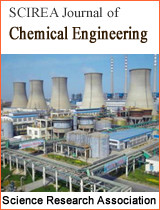Empirical investigation of performance of nano bed for industrial wastewater treating
DOI: 322 Downloads 37404 Views
Author(s)
Abstract
The techniques of wastewater treatment have been considered, recently. The performance of usage of nano ferric oxide and aluminum oxide as coagulant is evaluated in this work, experimentally. The experiments were conducted to measure the important parameters in quality of treatment by addition of four different amounts of nano two metal oxides 1, 1.5, 2 and 2.5 gr. The value of pH, color, color/color0, zeta potential, slug volume index, total dissolved solids conductivity, turbidity, ammonia, sulfide, heavy metals, phenol, oil and grease is investigated. The results show the better performance of nano ferric oxide in coagulation and flocculation by lower amount of zeta potential, ammonia, phenol and sulfide and oil, grease elimination than aluminum oxide. However the value of slug volume index in treated wastewater by nano ferric oxide is higher than that is obtained with nano aluminum oxide.
Keywords
pretreatment reactor, sea ecosystem, softening process, wastewater treatment, desalination, total hardness, nano coagulants.
Cite this paper
Abdolrahim Zarei, Farshad Farahbod,
Empirical investigation of performance of nano bed for industrial wastewater treating
, SCIREA Journal of Chemical Engineering.
Volume 2, Issue 1, February 2017 | PP. 1-9.
References
| [ 1 ] | Al-Jasser A., 2011. Saudi wastewater reuse standards for agricultural irrigation: Riyadh treatment plants effluent compliance [J]. King Saudi University – Eng Sci, 23 : 1-8. |
| [ 2 ] | Gao B., Chu Y., Yue Q., 2009. Purification and characterization of Al13 species in coagulant polyaluminum Chloride [J]. J Environ Sci, 21: 18–22. |
| [ 3 ] | Jangkorn S., Kuhakaew S., Theantanoo S., Klinla-or H., Sriwiriyarat T.,2011, Evaluation of reusing alum sludge for the coagulation of industrial wastewater containing mixed anionic surfactants[J]. J Environ Sci, 23: 587-594. |
| [ 4 ] | Khiari R., Dridi-Dhaouadi S., Aguir Ch., Farouk Mhenni M., 2010. Experimental evaluation of eco-friendly flocculants prepared from date palm rachis [J]. J Environ Sci, 22: 1539-1543. |
| [ 5 ] | Lee S., Maniquiz M., Kim L.,2010.Characteristics of contaminants in water and sediment of a constructed. wetland treating piggery wastewater effluent [J]. J Environ Sci, 22: 940–945. |
| [ 6 ] | Nan J., He W., Song X., Li G., 2009. Impact of dynamic distribution of floc particles on flocculation effect [J]. J Environ Sci, 21:1059–1065. |
| [ 7 ] | Pa B., Roca J., Piáa A. B., 2009. Application of multicriteria decision analysis to jar-test results for chemicals selection in the physical–chemical treatment of textile wastewater [J]. J Hazard Mater, 164: 288–295. |
| [ 8 ] | Wu Q., Hua1 T., Zhou Q.,2011.Treatment and remediation of a wastewater lagoon using microelectrolysis and modified DAT/IAT methods [J]. J Environ Sci, 23: 388–395. |
| [ 9 ] | Setiawan A. A., Zhao Y., Nayar Ch. V., 2009. Economic analysis and environmental considerations of mini-grid hybrid power system with reverse osmosis desalination plant for remote areas [J]. Renew Energ, 34: 374–383. |
| [ 10 ] | Wang W., Li H., Wang X., Liu Y., 2010.Spatial variations of aluminum species in drinking water supplies in Xi'an studied applying geographic information system [J]. J Environ Sci , 22:519-525. |
| [ 11 ] | Wang Y., Zhoua W. Z., Gao B. Y., 2009. The effect of total hardness on the coagulation performance of aluminum salts with different Al species [J]. Sep Purif Technol, 66: 457–462. |
| [ 12 ] | Yana M. , Wang D., Ni J., Qu J.W., 2009. Natural organic matter (NOM) removal in a typical North-China water plant by enhanced coagulation: Targets and techniques [J]. Sep Purif Technol, 68: 320–327. |

